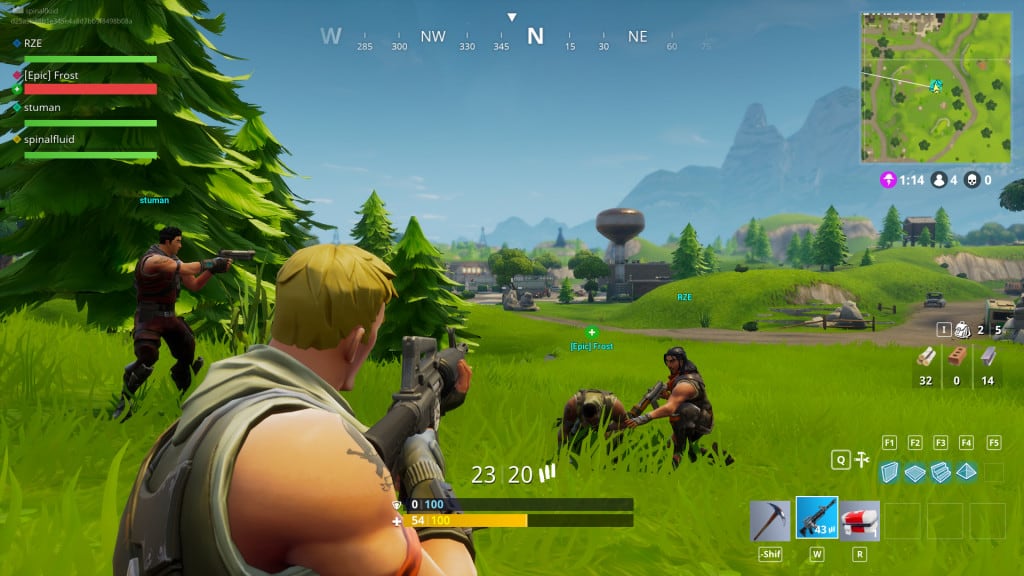Overcoming a Fortnite Addiction
Every year there’s a single video game that overshadows all others. In 2018, that game was Fortnite. In March of 2018, Fornite overtook League of Legends as the most-viewed game on Twitch. This was quite an accomplishment at the time considering League of Legends dominated this platform for years prior.

Now, nearly 3 years later, Fortnite has more than 80.4 million monthly active users. Nearly 4 million gamers play this battle royale-style game every single day. In 2021, Fortnite claimed the top spot among all other video games in this category.
Although the average Fortnite player is between 16 and 17 years old, the game’s youngest champion is just 8 years old! While some players might find this impressive, parents find it concerning. As Fortnite continues to dominate the gaming world and increasingly younger gamers are drawn to its playful characters, skins, and dance moves, the addiction rate is on the rise.
Here we’ll take a closer look at what makes Fortnite so popular and share tips for overcoming this addiction that can help both the addict themselves and assist concerned parents of addicts.
Content
What is Fortnite?

The battle royale version of this game allows players to choose from four modes: solo-play, doubles (2 players), trios (3 players), and squads (4 players). Unlike other shooter games that let you respawn, once you “die” in a Fortnite, it’s game over until you can join another open game.
Why is Fortnite so Appealing and Addictive?

Socializing with Friends (and Making New Ones!)
There’s nothing more important to young kids than their friendships. Fortnite and other multiplayer video games offer a safe way for kids to make friends, communicate, and socialize. What’s more, these online friendships surround a shared interest, making it easier for players to communicate and form strong bonds. This appeals to our fundamental need for social interaction and connection.
The same can be said for adults. Some people with social anxiety or a shy personality prefer to socialize online, in the comfort of their home, through a chat group or headset. Fortnite allows players to communicate in-game. What starts at a solo adventure can quickly turn into forming teams of 2, 3, or even 4 players. Surviving and winning in a battle royale takes teamwork, strategy, and problem-solving skills. Now, players are learning to work together toward a common goal which can help boost confidence and strengthen communication skills. While these are positive outcomes of playing Fortnite, they can also become addictive and make it increasingly difficult to succeed in the real world.
Low Barrier of Entry
The easier it is for people to access a game, the more likely they are to play and become addicted. Because Fortnite is free to download, kids can easily start playing without parent intervention. Even if they do ask their parents for permission, the “free” price tag is an attractive feature that most parents happily agree to. All of this means that the barrier of entry for playing Fortnite is very low. There are minimal obstacles in your way and players can download the game and start playing right away.
Triumph Circuit
Humans are naturally curious. This is especially true for children who are always learning, developing new skills, and craving knowledge. As kids pick up new skills, they continue to hone and improve on them. The more challenging a task is, the more intriguing it is. This mental process of meeting and overcoming challenges (and in the case of Fortnite and other video games, being rewarded for your efforts), is called the triumph circuit.
This psychological pattern of behavior makes overcoming challenges more and more appealing with every victory. Fortnite is a prime example of a game that engages players’ triumph circuit. Each battle starts with 100 players until a single player or team remains. This is a psychological high-stakes game of risk, pressure, and reward. Players must outwit and outmaneuver dozens of competitors to reign supreme. This makes a victory all the more satisfying, delivering a heavy dose of confidence and satisfaction.
Increased Dopamine
In addition to the triumph circuit, a chemical reaction occurs in the brain that compels Fortnite players to continue playing in an obsessive manner. Dopamine is a neurotransmitter that regulates the pleasure we feel when we engage in a satisfying activity. Playing a game that is fun and engaging, like Fortnite, triggers the brain to create and release dopamine.
Playing Fortnite delivers an intense adrenaline rush as players build forts to hide from the enemy, find and pursue other players and get closer to a victory. Every accomplishment delivers a hit of dopamine to the brain. Soon, players start associating pleasure and satisfaction with playing Fortnite. Over time, gamers will crave increased playing time. A single battle royale victory won’t satisfy them the way it used to. Now, they have to win consecutively or achieve a higher number of kills to feel that same level of pleasure. This dopamine dependency is what keeps kids and adults coming back for more.
New Features and Events
Fortnite knows how to keep things exciting! Every day at the same time, the game releases new items for purchase in the “Item Shop”. Here, players can use their credits or real money to purchase new skins (costumes), dance moves, backpacks, and weapons. These items are fun, colorful, making them even more attractive to younger players. They also follow themes including holidays and trending music. Young players are in a constant struggle to obtain the newest and coolest features in the “Item Shop”.
Fortnite is also known for its live events and concerts. Here players gather in a virtual party-like atmosphere — once again appealing to that need for social connection and interaction. The game also updates its maps every few months and releases new seasons, keeping players constantly engaged and on the edge of their seats.
Signs and Symptoms of Fortnite Addiction

Mood Swings and Irritability When You Can’t Play
This is one of the main, and most concerning, signs of video game addiction. As with any addiction, being unable to access your stimulus of choice (in this case, Fortnite) can cause extreme emotional distress. Violent outbursts, temper tantrums, and unexplained frustration are all common among kids that are addicted to Fortnite.
Parents of video game addicts are all too familiar with emotional outbursts after telling their children to turn off their gaming console or even grounding them from it. Players become addicted to the dopamine surge as well as all the features of the game like socializing with friends and seeing newly released items. The idea of missing out on something can be overwhelming for a child. If your youngster expresses emotional distress, mood swings, or even anger or sadness when denied access to Fortnite it may be a sign that they’ve become addicted.
Gamers of all ages experience mood swings and irritability when they can’t play Fortnite or another game they enjoy. Players that crave that dopamine release or are driven to unlock new features and levels may feel frustrated and angry when they can’t play. These mood swings and fluctuating emotions are a tell-tale sign that playing video games has morphed from an innocent pastime to a potentially dangerous addiction.
Loss of Interest in Other Activities
Does your child live and breathe for video games? If they think and talk about Fortnite from the moment they wake up until the time they go to sleep, it may be a sign that they’re addicted. Losing interest in other things they once enjoyed like sports, friends, and family activities is another sign that Fortnite is consuming their minds and lives in an unhealthy way.
Adult addicts may start shying away from hanging out with friends, exercising, or attending parties and other get-togethers. Gaming addicts start to believe that playing Fortnite is the only thing that brings them happiness. No other activity seems to deliver the same level of pleasure and satisfaction as their video game of choice.
Jeopardizing Important Responsibilities
For children, school is their main priority. Completing assignments, staying on task, doing homework, and studying are all obligations and expectations. This is in addition to other responsibilities like household chores. When Fortnite takes precedence over all other obligations and responsibilities, it may be a sign that your youngster is addicted.
Poor grades, missed assignments, and discipline problems at school may be an indication that your child is preoccupied with playing Fortnite. Many gaming addicts fantasize about their game of choice all day, every day, making it impossible to focus on much else. This can lead to your child missing important information and compromising their schoolwork. Discipline problems in school are another sign of gaming addiction and could be a result of the mood swings and irritability mentioned earlier. It’s important to note, though, that academic issues may have other underlying causes that have nothing to do with the fact that your child plays Fortnite. Contact your child’s teacher and the school system to determine if there are additional concerns with their development and learning.
Adults have their own set of responsibilities like going to work and paying household bills and expenses. When facing an addiction to Fortnite some adults let their daily obligations fall to the wayside. Slacking off at work, showing up late, or even calling out sick in order to play can all compromise their jobs and livelihood. Personal relationships also take a backseat for Fortnite addicts. When your mind is consumed by gameplay, it can be difficult to foster personal and professional relationships. This includes bonds with family, friends, and your significant other.
Being Dishonest or Deceptive
When addiction takes over, people often act in ways they never imagined they would. This includes lying, stealing, and being deceptive in order to support their habit. In this case, lying about how often you play Fortnite and how much money you spend on it can not only cause tension in your personal relationships but create financial issues.
Even though Fortnite is free to download, there are plenty of in-game purchases that cost real money. Most children need parental consent and credit card information to make these purchases. Having emotional outbursts over not being able to make these purchases is a sign of video game addiction in kids. In adults, spending exorbitant amounts of money on different features within the game or keeping these purchases a secret from your spouse or partner can cause not only distrust but financial stress.
The Dos and Don’ts of Overcoming a Fortnite Addiction

If you’re a parent who recognizes their child has a gaming addiction but is at a loss of how to handle it, or even where to start, there are a few things to keep in mind. Your initial reaction may be to take away their gaming console, ground them, or talk negatively about Fortnite. These are all acts of desperation and may not have the desired results.
Here are a few things to avoid when helping your child overcome their Fortnite addiction.
Don’t Take Away Digital Devices All Together
Cold turkey is rarely an effective method when overcoming any addiction, including one to video games. If you’ve removed your child’s gaming console and completely cut them off from playing, the results have likely been negative and in some cases, scary. Your child may have acted out verbally or physically. This is a very scary thing for parents and may result in you giving back full control over their gameplay, which is a form of negative reinforcement.
DO Remove the Gaming Device from the Bedroom
Instead of taking away their gaming console or PC completely, remove it from their bedroom and place it in a centrally located area like the family room or living room. This way, you can monitor their gameplay including how long they play, what they’re playing, and how they interact with other gamers. By placing their gaming device in a neutral location, you can oversee what they’re doing while also giving them time to play a game they enjoy.
Don’t Talk Negatively About the Game or Their Online Friends
Your initial reaction might be to talk negatively about Fortnite and the entire online community. Telling your child that their online friends aren’t “real” or that the game itself is a waste of their time and potential is a big hit to your child’s self-confidence and self-worth. The last thing you want to do is make your child feel bad about themselves, especially when Fortnite is giving them a sense of accomplishment, purpose, and acceptance — even if you don’t fully understand it.
DO Encourage Other Relationships and Skills
Instead of putting down the friends and skills your child has developed while playing Fortnite, encourage them to broaden their horizons and diversify their skillset. Acknowledge that their online friends are great but that they also need to socialize in person. Encourage them to join a local sports team, volunteer, or schedule playdates with classmates. When it comes to your child’s talents and skills, remember, winning a battle royale in Fortnite or building an impressive structure boosts their self-esteem. Instead of tearing that down, help them apply these skill sets and problem-solving skills to real life. Help them build a fort outside or explore the world of architecture and engineering. Find real-world applications for their in-game skills and accomplishments.
Other Ways to Positively Help Your Child’s Fortnite Addiction
In addition to the above-mentioned tips on what to do and not to do when handling your child’s Fortnite addiction, here are a few other techniques for parents.
- Set a daily time limit on gaming (2-3 hours per day including weekends)
- Require your child to complete any homework and physical activity before playing
- Set and maintain consistent boundaries
- No digital devices or gaming within 60 minutes of bedtime
- No digital devices or gaming at the dinner table or during family time
- No gaming in the morning before school
- Require your child to maintain in-person relationships, skills, and hobbies
Tips for Adults with a Fortnite Addiction
Fortnite addiction doesn’t discriminate. Although most players are under the age of 18, there are plenty of older players facing a similar addiction. In this case, you may not have a parent or even a partner to help you reign in your gameplay and take control of your addiction.
Here are a few ways adults can overcome a Fortnite addiction. You’ll notice these tips only differ slightly from those offered to parents for their kids.
- Keep a journal of how often you play and for how long. Then, slowly reduce your gameplay.
- Incorporate other healthy hobbies and activities into your day including exercise.
- Socialize with friends, family, and coworkers outside of the online community.
- Avoid playing video games too close to bedtime.
- Place your gaming console or PC in a central location so you can’t monopolize the area.
Another important step in overcoming an addiction to Fortnite is getting to the root of why you feel compelled to play. Everything from anxiety, depression, or stress to lack of personal motivation or accountability can make video games seem more attractive than real life. After all, being a productive adult takes hard work, responsibility, and is often stressful. Video games like Fortnite offer you an escape from these obligations and help you destress.
Self-help programs for gaming addiction are a viable option for adults. Not only can you complete these therapy programs in the comfort of your own home, but they offer a wide range of tools, resources, and methods for recovery including cognitive-behavioral therapy (CBT) and mindfulness.
If Fortnite is taking over your or your child’s life, it may be time to implement some changes and help regain a healthy balance between video games, daily responsibilities, and other beneficial activities.








